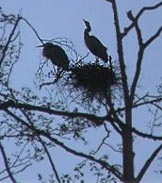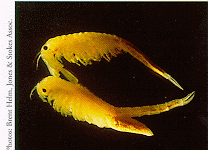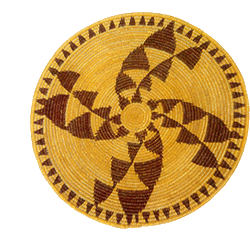Docent Circle: Field Notes Week of 2005-04-18
 Back East, the ever-popular and colorful American goldfinch breeds in July
to take advantage of ripening grass seed crops. But in California's
unique Mediterranean climate, grasses mature earlier in the year
and goldfinches correspondingly shift their nesting season as early
as May. Sometimes referred to as wild canaries, brilliant yellow
males with black foreheads launch into lively trills and twitters.
Meanwhile, females weave cup-shaped nests so fine that they will
hold water in a rain. The four to six eggs hatch in about a week
and a half, just in time for the fledglings to get their first
beakful of nutritious seeds. Watch for the gregarious goldfinches
all over the Laguna, in grassy areas and in large flocks feeding on
weeds of chicory, thistle and other plants.
Back East, the ever-popular and colorful American goldfinch breeds in July
to take advantage of ripening grass seed crops. But in California's
unique Mediterranean climate, grasses mature earlier in the year
and goldfinches correspondingly shift their nesting season as early
as May. Sometimes referred to as wild canaries, brilliant yellow
males with black foreheads launch into lively trills and twitters.
Meanwhile, females weave cup-shaped nests so fine that they will
hold water in a rain. The four to six eggs hatch in about a week
and a half, just in time for the fledglings to get their first
beakful of nutritious seeds. Watch for the gregarious goldfinches
all over the Laguna, in grassy areas and in large flocks feeding on
weeds of chicory, thistle and other plants.
 Great Blue Herons,
Great White Egrets, and Snowy Egretshave already arrived to
claim their place in the Laguna heronries. The male Blue
Herons were the first to arrive. While waiting for the female
to arrive, they defend the site from other males and display their
breeding plumage, stretching and fanning their decorative aigrette
nuptial feathers. Courtship dances commence as the female
takes up residence on the nest: the male offers her a twig, the
female takes the twig from the male's beak and carefully places it
in the nest while the male watches. Then the ritual is
repeated when the male flies off to find another perfect
stick.
Great Blue Herons,
Great White Egrets, and Snowy Egretshave already arrived to
claim their place in the Laguna heronries. The male Blue
Herons were the first to arrive. While waiting for the female
to arrive, they defend the site from other males and display their
breeding plumage, stretching and fanning their decorative aigrette
nuptial feathers. Courtship dances commence as the female
takes up residence on the nest: the male offers her a twig, the
female takes the twig from the male's beak and carefully places it
in the nest while the male watches. Then the ritual is
repeated when the male flies off to find another perfect
stick.
 For most of the year, vernal pools are dry, grassy depressions
in the earth. But when winter rains soak our summer-parched soil,
these poorly-drained bowls fill with water and burst into life.
For most of the year, vernal pools are dry, grassy depressions
in the earth. But when winter rains soak our summer-parched soil,
these poorly-drained bowls fill with water and burst into life.
 Though vernal pools dot California's grasslands, they're found
almost nowhere else on Earth. The pools host myriad plant and
animal species that have evolved speedy life cycles designed to
take advantage of the brief wet season. Among these are small
crustaceans known as fairy and tadpole shrimp, which
hatch from dormant, buried eggs just a few days after pools fill
with rain. Fairy shrimp are inch-long lacey animals which glide
upside down with graceful, rhythmic beats of their two rows of
dainty legs. Walnut-sized tadpole shrimp sport a hard, rounded
shell and plow through mud on pool bottoms. Though the shrimps'
hardy eggs can lie dormant for years and are spread with wind-borne
dust, many species have landed on the endangered species list
because their habitat -- California's rolling hills and flat
valleys -- is rapidly giving way to development.
Though vernal pools dot California's grasslands, they're found
almost nowhere else on Earth. The pools host myriad plant and
animal species that have evolved speedy life cycles designed to
take advantage of the brief wet season. Among these are small
crustaceans known as fairy and tadpole shrimp, which
hatch from dormant, buried eggs just a few days after pools fill
with rain. Fairy shrimp are inch-long lacey animals which glide
upside down with graceful, rhythmic beats of their two rows of
dainty legs. Walnut-sized tadpole shrimp sport a hard, rounded
shell and plow through mud on pool bottoms. Though the shrimps'
hardy eggs can lie dormant for years and are spread with wind-borne
dust, many species have landed on the endangered species list
because their habitat -- California's rolling hills and flat
valleys -- is rapidly giving way to development.
 When trees and bushes
burst into new growth during the warming days of spring, the
cambium (a layer of cells just beneath the bark) also begins to
grow rapidly. As the cells divide and expand, they loosen the
bark's grip on underlying wood, a condition known as bark
slip. Native California basketweavers, orchardists, and loggers
take advantage of this phenomenon. Basketweavers
collect young twigs and shoots of willow, redbud, hazel, gray pine,
sumac, and big leaf maple during barkslip. After peeling
away the bark, the weavers use the smooth, white, and supple sticks
for the foundation (warp) of their baskets. The slipping period can
be brief --a week or ten days for hazel, for example. Basketweavers
who miss the harvest in one area can find good material further
north or at higher elevations where spring arrives later. Fruit
tree growers have to wait for bark slip to use two of the most
common grafting techniques: budding and bark grafting. And builders
who work with pole construction like to harvest Douglas-fir and
incense cedar in the spring when they can practically peel the bark
from logs with their bare hands.
When trees and bushes
burst into new growth during the warming days of spring, the
cambium (a layer of cells just beneath the bark) also begins to
grow rapidly. As the cells divide and expand, they loosen the
bark's grip on underlying wood, a condition known as bark
slip. Native California basketweavers, orchardists, and loggers
take advantage of this phenomenon. Basketweavers
collect young twigs and shoots of willow, redbud, hazel, gray pine,
sumac, and big leaf maple during barkslip. After peeling
away the bark, the weavers use the smooth, white, and supple sticks
for the foundation (warp) of their baskets. The slipping period can
be brief --a week or ten days for hazel, for example. Basketweavers
who miss the harvest in one area can find good material further
north or at higher elevations where spring arrives later. Fruit
tree growers have to wait for bark slip to use two of the most
common grafting techniques: budding and bark grafting. And builders
who work with pole construction like to harvest Douglas-fir and
incense cedar in the spring when they can practically peel the bark
from logs with their bare hands.
Back to the Field Notes Archive
 Back East, the ever-popular and colorful American goldfinch breeds in July
to take advantage of ripening grass seed crops. But in California's
unique Mediterranean climate, grasses mature earlier in the year
and goldfinches correspondingly shift their nesting season as early
as May. Sometimes referred to as wild canaries, brilliant yellow
males with black foreheads launch into lively trills and twitters.
Meanwhile, females weave cup-shaped nests so fine that they will
hold water in a rain. The four to six eggs hatch in about a week
and a half, just in time for the fledglings to get their first
beakful of nutritious seeds. Watch for the gregarious goldfinches
all over the Laguna, in grassy areas and in large flocks feeding on
weeds of chicory, thistle and other plants.
Back East, the ever-popular and colorful American goldfinch breeds in July
to take advantage of ripening grass seed crops. But in California's
unique Mediterranean climate, grasses mature earlier in the year
and goldfinches correspondingly shift their nesting season as early
as May. Sometimes referred to as wild canaries, brilliant yellow
males with black foreheads launch into lively trills and twitters.
Meanwhile, females weave cup-shaped nests so fine that they will
hold water in a rain. The four to six eggs hatch in about a week
and a half, just in time for the fledglings to get their first
beakful of nutritious seeds. Watch for the gregarious goldfinches
all over the Laguna, in grassy areas and in large flocks feeding on
weeds of chicory, thistle and other plants. Great Blue Herons,
Great White Egrets, and Snowy Egretshave already arrived to
claim their place in the Laguna heronries. The male Blue
Herons were the first to arrive. While waiting for the female
to arrive, they defend the site from other males and display their
breeding plumage, stretching and fanning their decorative aigrette
nuptial feathers. Courtship dances commence as the female
takes up residence on the nest: the male offers her a twig, the
female takes the twig from the male's beak and carefully places it
in the nest while the male watches. Then the ritual is
repeated when the male flies off to find another perfect
stick.
Great Blue Herons,
Great White Egrets, and Snowy Egretshave already arrived to
claim their place in the Laguna heronries. The male Blue
Herons were the first to arrive. While waiting for the female
to arrive, they defend the site from other males and display their
breeding plumage, stretching and fanning their decorative aigrette
nuptial feathers. Courtship dances commence as the female
takes up residence on the nest: the male offers her a twig, the
female takes the twig from the male's beak and carefully places it
in the nest while the male watches. Then the ritual is
repeated when the male flies off to find another perfect
stick. For most of the year, vernal pools are dry, grassy depressions
in the earth. But when winter rains soak our summer-parched soil,
these poorly-drained bowls fill with water and burst into life.
For most of the year, vernal pools are dry, grassy depressions
in the earth. But when winter rains soak our summer-parched soil,
these poorly-drained bowls fill with water and burst into life.
 Though vernal pools dot California's grasslands, they're found
almost nowhere else on Earth. The pools host myriad plant and
animal species that have evolved speedy life cycles designed to
take advantage of the brief wet season. Among these are small
crustaceans known as fairy and tadpole shrimp, which
hatch from dormant, buried eggs just a few days after pools fill
with rain. Fairy shrimp are inch-long lacey animals which glide
upside down with graceful, rhythmic beats of their two rows of
dainty legs. Walnut-sized tadpole shrimp sport a hard, rounded
shell and plow through mud on pool bottoms. Though the shrimps'
hardy eggs can lie dormant for years and are spread with wind-borne
dust, many species have landed on the endangered species list
because their habitat -- California's rolling hills and flat
valleys -- is rapidly giving way to development.
Though vernal pools dot California's grasslands, they're found
almost nowhere else on Earth. The pools host myriad plant and
animal species that have evolved speedy life cycles designed to
take advantage of the brief wet season. Among these are small
crustaceans known as fairy and tadpole shrimp, which
hatch from dormant, buried eggs just a few days after pools fill
with rain. Fairy shrimp are inch-long lacey animals which glide
upside down with graceful, rhythmic beats of their two rows of
dainty legs. Walnut-sized tadpole shrimp sport a hard, rounded
shell and plow through mud on pool bottoms. Though the shrimps'
hardy eggs can lie dormant for years and are spread with wind-borne
dust, many species have landed on the endangered species list
because their habitat -- California's rolling hills and flat
valleys -- is rapidly giving way to development.
 When trees and bushes
burst into new growth during the warming days of spring, the
cambium (a layer of cells just beneath the bark) also begins to
grow rapidly. As the cells divide and expand, they loosen the
bark's grip on underlying wood, a condition known as bark
slip. Native California basketweavers, orchardists, and loggers
take advantage of this phenomenon. Basketweavers
collect young twigs and shoots of willow, redbud, hazel, gray pine,
sumac, and big leaf maple during barkslip. After peeling
away the bark, the weavers use the smooth, white, and supple sticks
for the foundation (warp) of their baskets. The slipping period can
be brief --a week or ten days for hazel, for example. Basketweavers
who miss the harvest in one area can find good material further
north or at higher elevations where spring arrives later. Fruit
tree growers have to wait for bark slip to use two of the most
common grafting techniques: budding and bark grafting. And builders
who work with pole construction like to harvest Douglas-fir and
incense cedar in the spring when they can practically peel the bark
from logs with their bare hands.
When trees and bushes
burst into new growth during the warming days of spring, the
cambium (a layer of cells just beneath the bark) also begins to
grow rapidly. As the cells divide and expand, they loosen the
bark's grip on underlying wood, a condition known as bark
slip. Native California basketweavers, orchardists, and loggers
take advantage of this phenomenon. Basketweavers
collect young twigs and shoots of willow, redbud, hazel, gray pine,
sumac, and big leaf maple during barkslip. After peeling
away the bark, the weavers use the smooth, white, and supple sticks
for the foundation (warp) of their baskets. The slipping period can
be brief --a week or ten days for hazel, for example. Basketweavers
who miss the harvest in one area can find good material further
north or at higher elevations where spring arrives later. Fruit
tree growers have to wait for bark slip to use two of the most
common grafting techniques: budding and bark grafting. And builders
who work with pole construction like to harvest Douglas-fir and
incense cedar in the spring when they can practically peel the bark
from logs with their bare hands.